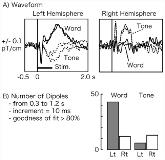NEUROMAGNETIC SUSTAINED FIELD IN RECOGNITION MEMORY TASK FOR SPOKEN JAPANESE WORDS
Abstract number :
1.479
Submission category :
Year :
2004
Submission ID :
4507
Source :
www.aesnet.org
Presentation date :
12/2/2004 12:00:00 AM
Published date :
Dec 1, 2004, 06:00 AM
Authors :
1Nobukazu Nakasato, 2Kazuyo Tanji, 1Hiroshi Shamoto, 2Kyoko Suzuki, 3Toshihiro Kumabe, 1Akitake Kanno, 4Shinya Sonobe, and 1Satoru Fujiwara
Neuromagnetic fields evoked by a spoken-word recognition task show hemispheric asymmetry in native English and Spanish speakers but not in Mandarin-Chinese speakers (Neuropsychologia 2004;42:967). Here, we tested whether such tasks can be used to define the language-dominant hemisphere in native Japanese speakers. Neuromagnetic fields evoked by a spoken-word recognition task and a tone burst of 1000 Hz were measured using a helmet-shaped magnetoencephalography (MEG) system in 9 patients (7 males and 2 females, aged from 23 to 64 years old) with medically intractable epilepsy (n = 3), gliomas (n = 5), and cavernous angioma (n = 1) as a part of presurgical functional evaluation. The language-dominant hemisphere was later confirmed by correlation of the lesion and language deficit or by functional mapping with electrical cortical stimulation. All stimuli had a duration of 600 ms. One hundred responses were recorded between 500 ms prestimulus (baseline) and 2,000 ms after the stimulus onset. Digital filtering of 0.2-25 Hz was applied to all evoked data. N100m activity was found bilaterally for all stimuli followed by sustained fields from approximately 300 ms to 1200 ms (Fig. 1A). Equivalent current dipoles (ECDs) of the N100m were estimated on the posterior part of the upper surface of the bilateral temporal lobes. ECDs of the sustained fields were estimated in the bilateral temporo-parietal lobes. In 8 patients, the amplitudes and goodness-of-fit values in the ECD model for the sustained fields were dominant in the left hemisphere for the word-recognition task, but in the right hemisphere for the pure tone (Fig. 1B). The language-dominant hemisphere was later confirmed as the left in all these 8 patients. In contrast, the language-dominant hemisphere of one patient, who showed reversed laterality in presurgical MEG, was later found to be the right.[figure1] Combination of the spoken-word recognition task may be used to define the language-dominant hemisphere in native Japanese speakers. Cross-linguistic study may be necessary to confirm whether the sustained field can be used to determine the language-dominant hemisphere in speakers of other languages.
